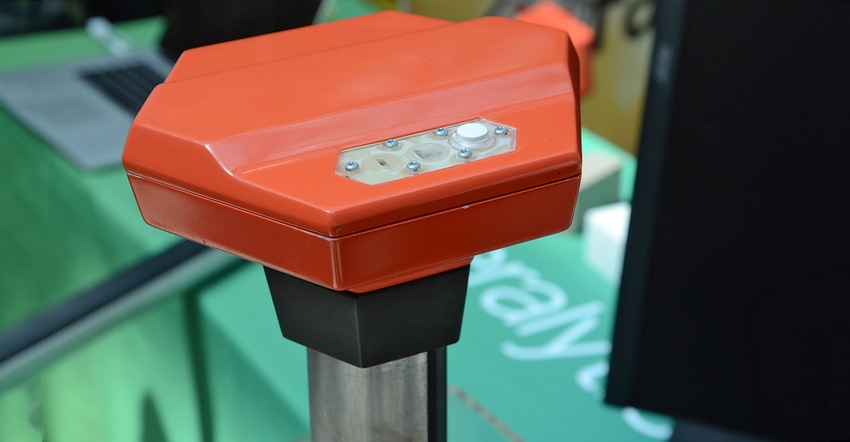July 27, 2018

Anyone following the ag tech world can see that a lot of innovation is focused on the industry. The many startup companies working to tackle key challenges of agriculture are looking at several opportunities and working to offer innovative solutions. One area getting more attention is crop sensors, and two on display at the recent InfoAg Conference show what’s possible today.
Field sensors offer the potential for capturing real-time information that can be shared to apps and used for in-season decision-making. Advancements in sensor technology with the creation of solid-state chips that can measure a range of factors in air, water and soil are helping move this tech forward.

FULL SENSOR: This display shows what’s happening in the Teralytic NPK sensor — from the top to 36 inches below the soil surface.

Teralytic made the claim at the conference that it is launching the first wireless NPK (nitrogen-phosphorus-potassium) sensor to the market. The probe has 26 sensors, including the NPK tech aimed to provide a range of information from the field in real time. “First, soil sampling is labor-intensive,” said Lachlan Turley, Teralytic. “To develop a variable-rate prescription, you have to collect a number of samples and send them to the lab. That takes time.”
With this new sensor, the farmer would have access to real-time soil quality information. The probe has an orange box on top that captures microclimate information. This can add local weather information as another layer in the data service in addition to soil information. “The challenge is having soil information when needed,” said Teralytic CEO Steve Ridder during his sponsor presentation at the conference. “There is a growing need for real-time data on soils and soil fertility.”
And while farmers may want the information, he points to a growing list of stakeholders who also want to know what’s happening with nutrient management and soil issues on the farm, from government regulators to retailers concerned about farm sustainability.
3 depths
The Teralytic probe has the weather microclimate measuring sensor on top, which sits close to the soil surface and can even measure sunlight hitting the ground. That measurement can give you an idea how fast the canopy is closing on the crop.
At 6, 18 and 36 inches, there are sensors that Ridder said provide a stratified view of the soil layers. The unit even measures oxygen and carbon dioxide from the soil to determine how well-aerated the soil is.
Information from the probe is transmitted to an information cloud using LoRa technology — this low-power network tech links sensors in a field to a gateway. That final step is a cellular communication tool that moves the information to the cloud. The communication service is part of the cost for this tool.
Ridder explained that sensors would be placed every 10 to 50 acres, depending on what the farmer wants to measure. Higher-value crops may warrant more sensors to capture that microclimate information on sunlight, temperature, relative humidity and other factors. Adding real-time movement of soil nutrients offers potential for precision fertility management.
The sensor information is available through an application where farmers can also add readily available soil information to provide added information for decision-making.
Cost for the Teralytic sensor is $200 for each sensor probe, and $300 per probe for a subscription per year. The probe must be installed using a special auger that ensures the probe maintains soil contact when installed.
The company is taking pre-orders for the probes for delivery in time for the 2019 season. There’s a 10-probe minimum order for the service. You can learn more at teralytic.com.

WEATHER MONITOR: Arable, a California-based startup, has created a comprehensive monitor that measures everything from rainfall to plant health.

More than a weather sensor
Solid-state sensing technology gets more sophisticated every day. The Arable Mark is an innovative sensor that can measure a range of field factors and provide what the company calls “granular ground truth.”
“The sensor incorporates a lot of information,” said Hans Specht, Arable. “It’s weather station to measure rainfall, and it can measure temperature, relative humidity, barometric pressure and plant health.”
The unit has sensors on top and below, and incorporates a cellular modem to send information to the cloud in real time. The unit sits about 3 feet above the crop canopy, but may be placed higher at first, with the crop growing to meet the sensor. Adam Wolf, the sensor’s developer, noted that as the crop grows, the width of the circle measuring plant health — using a Normalized Difference Vegetation Index image — would simply narrow.
With the information this multisensor tool captures, farmers can measure precipitation, evapotranspiration, solar radiation, plant health, and harvest and event time. The information from this tool is transmitted to the cloud. When it’s brought into the company’s integrated analytics tool, it provides a wide range of information for crop management. And the software can pull information from other types of sensors, too, for added data management.
Crop sensor technology continues to advance. The Arable Mark cost $780 for the sensor device, and access to the analytics dashboard is $580 per year. You can learn more about the system and the software at arable.com.
With these tools, farmers could get field-level information delivered throughout the growing season; it offers the potential for advanced input and crop management.
About the Author(s)
You May Also Like






